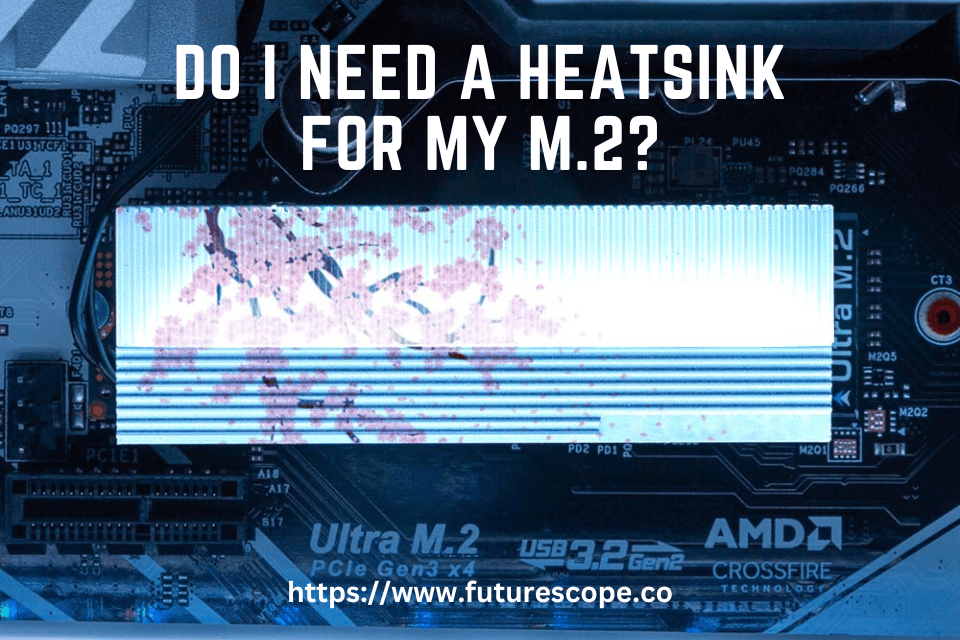What We Have Covered in This Article
Last Updated on March 18, 2023 by Editor Futurescope
M.2 is a type of solid-state drive (SSD) that is often used in laptops and other small devices. While M.2 drives are designed to be more durable and heat-resistant than traditional SSDs, they can still overheat if they are used for extended periods of time or if they are placed in an environment that is not well-ventilated. For this reason, it is generally recommended that users install a heatsink on their M.2 drive to help dissipate heat and prevent overheating.
If you have an M.2 solid state drive (SSD), you may be wondering if you need a heatsink for it. The answer is: it depends. M.2 SSDs are designed to run cooler than traditional 2.5-inch SSDs, so they typically don’t require a heatsink. However, if your M.2 SSD is going to be used for high-performance applications or in a hot environment, a heatsink can help keep it cool and improve its performance and longevity.
Heatsinks for M.2 SSDs are relatively inexpensive and easy to install, so if you’re not sure whether or not you need one, it’s probably worth getting one just to be safe.
Does Your M.2 NVMe SSD Need a Heatsink
What is an M.2 Heatsink?
A heatsink is a device that helps to dissipate heat away from an electronic component or other object. There are two main types of heatsinks: active and passive. Active heatsinks have a fan or other means of moving air over the surface of the heatsink, while passive ones rely on convection and radiation to cool the device.
Both types of heatsinks are used in computer systems to cool CPUs and GPUs. They are also used in power amplifiers, high-powered lasers, LED light arrays and many other applications where preventing overheating is critical. The efficiency of a heatsink depends on its design as well as the materials it is made from.
The most common material for making passive heatsinks is aluminum, which has good thermal conductivity but isn’t very durable. Copper is another popular choice for both active and passive heatsinks because it has even better thermal conductivity than aluminum. However, copper is much more expensive than aluminum so it isn’t always feasible to use it in mass-produced devices.
Does an NVMe M.2 SSD Come with a Heatsink?
It’s highly unlikely that an NVMe drive will come with a heatsink. However, it’s possible, especially if you buy from an OEM like Dell, HP, or Apple. Large corporations may use their own heatsinks for M.2 SSDs to keep them cooler and more reliable. To be absolutely sure, check the product package.
Why Do I Need a Heatsink for My M.2 SSD?
An M.2 SSD is a small form factor solid state drive that is used in laptops, computers and other devices that require storage.
While M.2 SSDs are much faster than traditional hard drives, they can also get quite hot when in use. This is why it is important to have a heatsink for your M.2 SSD – to help keep it cool and prevent overheating. Heatsinks are available in a variety of materials, such as aluminum or copper, and they work by dissipating heat away from the M.2 SSD.
Heatsinks usually attach to the M.2 SSD via thermal adhesive or screws, and some even come with fans for additional cooling power. If you are using your computer for tasks that require a lot of storage access or put strain on your system resources, then it is definitely worth considering getting a heatsink for your M.2
SSD!
What Happens if You Don’t Have a Heatsink?
NVMe M.2 SSDs will work normally even if they do not have a heatsink attached to them. They’re designed to operate within the stated temperature range of 0°C to 70°C, which is too wide to cause any problems. Only when these temperatures are exceeded can you expect an issue with stability and reliability.
How Do I Install a Heatsink on My M.2 SSD?
If you’re looking to install a heatsink on your M.2 SSD, there are a few things you’ll need to take into account.
First, check with your SSD manufacturer to see if they have any specific instructions or requirements for installing a heatsink. Next, consider the size and shape of your heatsink in relation to the size and shape of your M.2 slot. You’ll want to make sure that the heatsink will fit properly without impeding any other components in your system.
Finally, think about how you’ll attach the heatsink to your SSD. Some options include adhesive thermal pads or mounting screws. Once you’ve taken all of these factors into account, you’re ready to install your new heatsink!


Can an M.2 SSD Get Too Hot?
The heatsink fits directly toward the PCB of an NVMe SSD and has no direct connection to the NAND, controller, or DRAM. In this way, the heatsink will only affect the heat generation of these components, which is usually negligible. As long as you choose a quality heatsink, you can expect normal performance. But if you overclock your drive, it’s possible that a heatsink may slow down its performance.
Does a Heatsink Affect Performance?
A heatsink can positively affect the performance of an NVMe M.2 SSD by helping to dissipate heat and maintain optimal operating temperatures. By keeping the temperature within a safe range, a heatsink can prevent thermal throttling, which occurs when the SSD slows down its performance to avoid overheating. This means that a good-quality heatsink can potentially improve the performance and longevity of your M.2 SSD. However, it’s important to note that a poorly designed or improperly installed heatsink may not provide any significant benefits or could even negatively impact performance.
Conclusion
If you’re wondering whether or not you need a heatsink for your M.2, the answer is most likely no. M.2 drives typically don’t get as hot as other types of drives, so they don’t require a heatsink to keep them cool. However, if you’re using your M.2 drive for gaming or other intensive tasks, you may want to consider getting a heatsink to help keep it cool.









